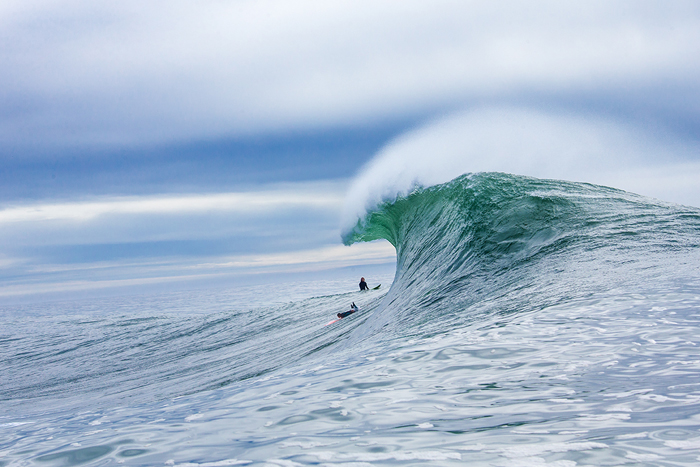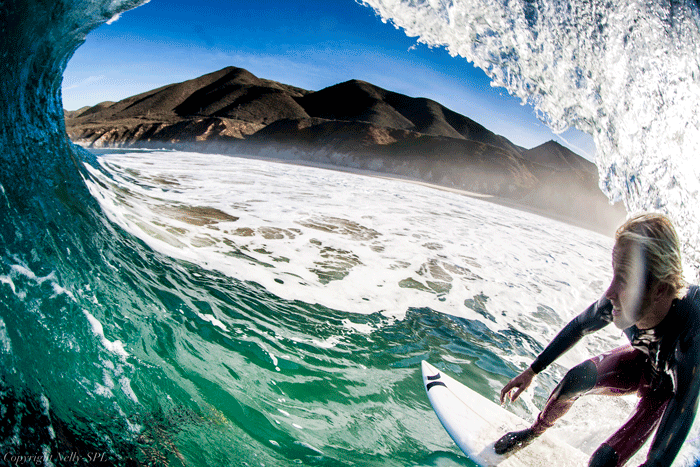- Paddling My Own Canoe - 10/01/2018
- West Coast Board Riders Club - 10/01/2018
- Never Too Oldfor Gold - 07/29/2018
Turning the tide from aggressive localism to hometown pride
By Haven Livingston • Photos by Ron Lyon

Rob Machado surfing in a club competition (Encinitas Board Riders).
A GROWING MOVEMENT OF SURF CLUBS on the left coast are trying to turn the tide from aggressive localism towards a hometown pride that gives back to the community. The West Coast Board Riders was established in 2017 by three surfers born and raised in Huntington Beach. They picked up the concept of local surf clubs, mixed it with Australian inter-club competition and added their own twist of multi-generational team events. The result is sweeping up the coast like a good southern swell.
Casey Wheat, Chris Moreno and Ziggy Williams got the idea for an all ages team contest while conducting a photo shoot for their clothing company, Sport of Kings Forever Young. They had rounded up surfers ranging from groms to old guys to model their garments. “Growing up as a surfer one of the unique things for me was being friends with so many different generations,” said Wheat. The trio decided to use that idea to form a California-wide club surf series and get away from the selfish individualism of standard surf contests.
They admired the way Australian coastal towns each have their own surf club and engage in friendly, but fierce competitions. Why not mix the concepts of club competitions and multi-generational teams? It seemed like the perfect way to push the direction of surfing towards building a more inclusive community.
The West Coast Board Riders is a collective of localized surf clubs that come together for a series of competitions that eventually culminate in a California-wide championship event. The ultimate prize is bragging rights. Their mission statement reads, “A community of brothers and sisters across generations, united through city surf clubs and friendly competition, with a deep passion for surfing and a positive movement that pays it forward to the youth.” When clubs aren’t competing, they’re looking for ways to give back to their own community.
Surfers have a notoriously bad rap for being hyper possessive about their home break. Localism in surfing is known to have divided neighborhoods, led to fist fights, flat tires and worse, and has generally been a dark shadow over surfing culture. It’s all a bit ironic given that many surfers claim to live by the aloha spirit. Surfers want to show pride for where they come from, but that doesn’t usually manifest as a warm invitation to come surf with them. These clubs, in part, are an attempt to change the way all surfers, but especially the youth, can act as respectable ambassadors of their sport.
WCBR lays out guideline rules, but specifics are up to each club. In general, anyone can join a club, but competing members must meet the requirements of having lived locally for at least five years or two years for school kids under 18 (exceptions made for military families and special circumstances). This local requirement prevents clubs from recruiting top notch surfers to join them for short periods of time and ensures that each member of the club has invested time into their town.
So far there are 12 clubs: Carlsbad, Dana Point, Encinitas, Huntington, Laguna, Newport, San Clemente, Santa Cruz, Seal Beach, San Luis Obispo, South Bay and Ventura. Williams said they have reached out to clubs on the east coast to help get them started so eventually there could be east to west coast championships. Plans are penciled in to do the same with Japan and Australia.
Competitions are between clubs, not individuals. Each club can send a maximum of four members in each of the seven age categories (14 & under, 15-19, 20-29, 30-39, 40-49, 50 & up, girls and women any age). Each age group gets a one-hour heat. The format is tag team style with one team member in the water at a time surfing a maximum of three waves each. Surfers have to strategize to make sure every team member has enough time to get a scoring wave before coming back to the beach to tag in the next teammate. In the end, the club with the most total points wins.
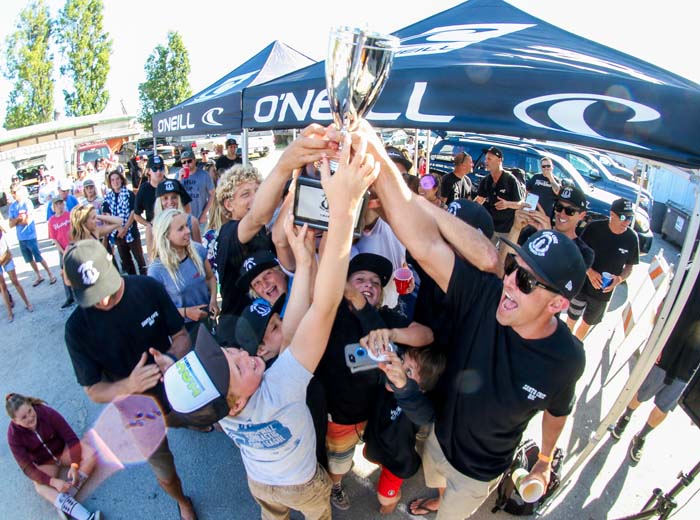
Santa Cruz Board Riders celebrating after clinching the WCBR Northern Division.
“In most competitions surfers only stick around for their own heat and they rarely watch the whole event,” said Shane Skelton, president of the Santa Cruz Board Riders club. “This year Nat Young told me at a club competition that this was the first time he had ever stayed and watched the whole contest, and had a super fun time doing it.”
The all for one and one for all format gives everyone a vested interest in how all members of their club perform. The groms get coaching and watch older generations to learn the ropes, the older generation is inspired by the youth, and everyone cheers on everybody else.
Williams and Wheat both point to the Santa Cruz Board Riders as the leading example in club management. SCBR has formed a nonprofit organization with former manager of the Coldwater Classic surf contest, Shane Skelton, as the president. Unlike some clubs who hand-pick competitors for the best possible team, the Santa Cruz club reserves two open spots for top competitors returning from the previous competition and holds trial heats for those who want to compete for the remaining two spots in each division.
The Santa Cruz club will be heading into the WCBR State Championships this fall ranked as number one for the northern division. The southern division championships will be held October 6th in San Clemente. The top two teams plus one wild card team from north and south will be competing in the State Championships on November 10th at South Side Huntington Beach pier.
For members who aren’t interested in competing there are local events to join such as fundraising BBQ’s and events that offer free surf lessons to the public. While the majority of club members are still white males, they are beginning to reach out to the community in an effort to diversify.
Other clubs have conducted beach clean ups and offered free classes for CPR, first aid and surf rescue – since surfers are usually the first on scene for near shore emergencies. Some clubs have partnered with organizations to put on events like Operation Surf – a surf program that supports wounded vets and active military past the trauma of war. Williams sees the opportunity of the clubs to act as a pool of volunteers for other organizations’ events as one of their great strengths.
While they have a lot of work ahead of them, the door is open for anyone who wants to join in the effort to change the culture of surf clubs. All of the clubs are in their infancy, but the common goal is to develop more community programs to share what they love most, the sport of surfing.
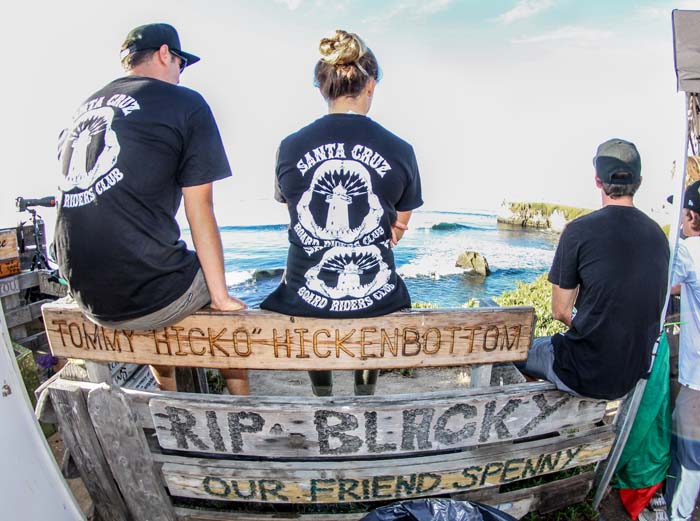
Santa Cruz Board Riders cheering on their team.
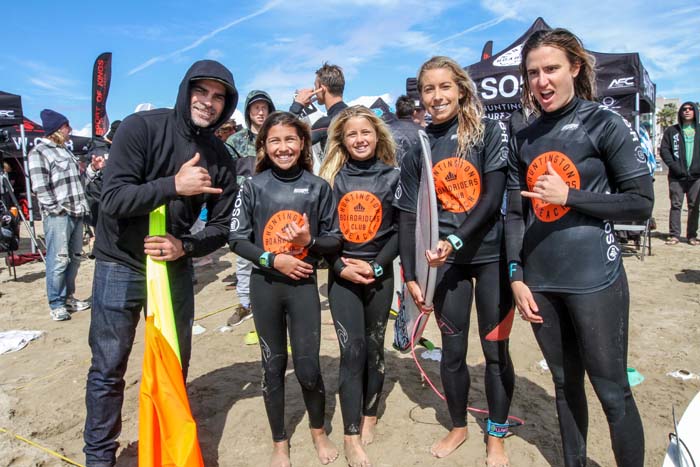
HB Board Riders coach Danny Nichols and the girls team.



